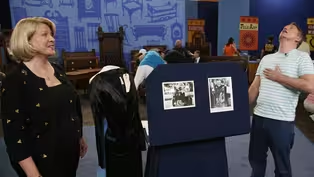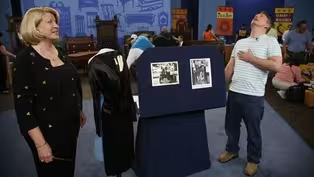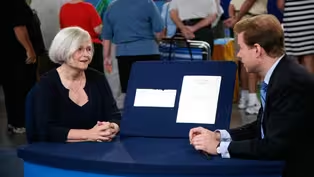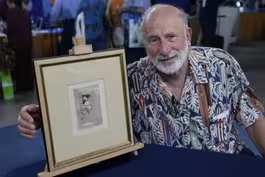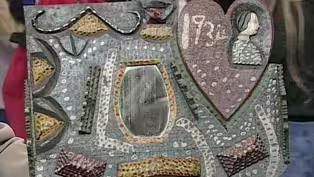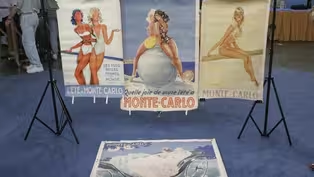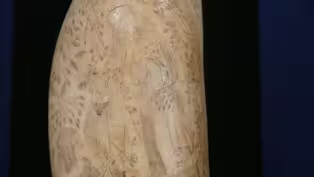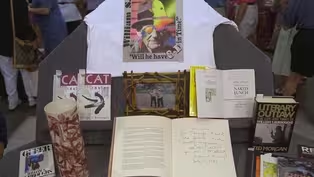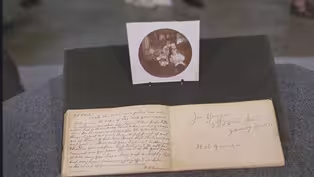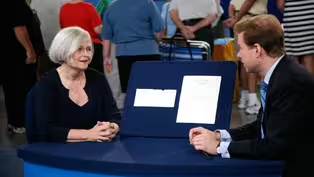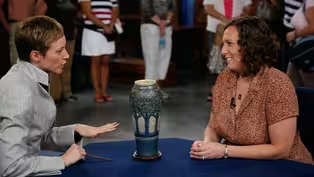
Special: Naughty or Nice
Season 14 Episode 20 | 53m 2sVideo has Closed Captions
Roadshow offers appraisals to satisfy everyone's wish list in this special edition.
ANTIQUES ROADSHOW's special edition, "Naughty or Nice," features favorite appraisals from past seasons to satisfy everyone's wish list. Highlights include: a Temperance lithograph illustrating the evils of imbibing spirits; a letter from Gerald Ford to his kindergarten teacher who called him "naughty little Gerry Ford;" and a dress worn by Marilyn Monroe in the film Some Like It Hot.
Problems playing video? | Closed Captioning Feedback
Problems playing video? | Closed Captioning Feedback
Funding for ANTIQUES ROADSHOW is provided by Ancestry and American Cruise Lines. Additional funding is provided by public television viewers.

Special: Naughty or Nice
Season 14 Episode 20 | 53m 2sVideo has Closed Captions
ANTIQUES ROADSHOW's special edition, "Naughty or Nice," features favorite appraisals from past seasons to satisfy everyone's wish list. Highlights include: a Temperance lithograph illustrating the evils of imbibing spirits; a letter from Gerald Ford to his kindergarten teacher who called him "naughty little Gerry Ford;" and a dress worn by Marilyn Monroe in the film Some Like It Hot.
Problems playing video? | Closed Captioning Feedback
How to Watch Antiques Roadshow
Antiques Roadshow is available to stream on pbs.org and the free PBS App, available on iPhone, Apple TV, Android TV, Android smartphones, Amazon Fire TV, Amazon Fire Tablet, Roku, Samsung Smart TV, and Vizio.
Buy Now
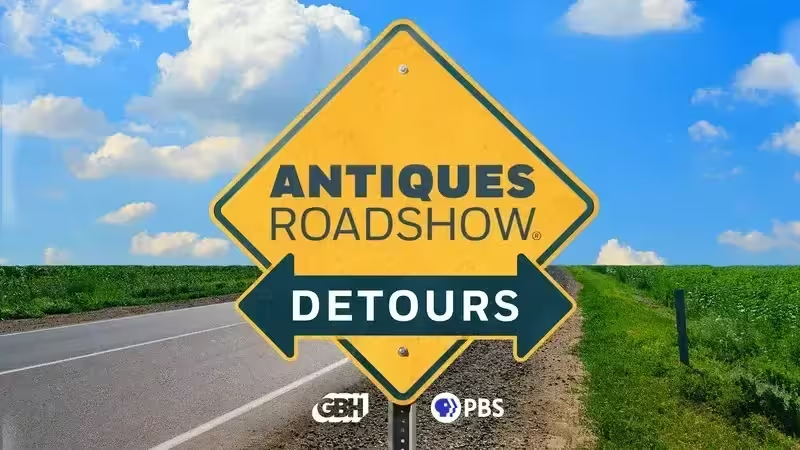
ANTIQUES ROADSHOW DETOURS
Ever wondered what happens to the treasures featured on America’s beloved ANTIQUES ROADSHOW after the cameras leave town? Host Adam Monahan tracks down the juicy afterlives of your favorite finds from PBS’s hit series.Providing Support for PBS.org
Learn Moreabout PBS online sponsorshipWe've made our list and checked it twice.
Now, which of these are naughty or nice?
WOMAN: My grandmother was Gerald Ford's kindergarten teacher.
She would call him "naughty little Jerry Ford."
She said, "I have these pornographic books.
Should I throw them away?"
And I said, "Heavens, no."
I'm about ready to fall over.
Stay tuned for these moments and more in our special edition, "Antiques Roadshow: Naughty or Nice."
♪ ♪ (firecrackers exploding) ANNOUNCER: Now, the people who make "Antiques Roadshow" possible.
Welcome to "Antiques Roadshow."
Hi, I'm Mark Walberg, and this is "Naughty or Nice."
What's a good antique story without a little scandal or mischief?
Well, over the years, we've discovered that the old saying "There are two sides to every coin" applies to antiques as well.
Naughty or nice, or a bit of both?
You decide.
I brought in a letter from former President Gerald R. Ford to my grandmother.
He moved here in about 1913.
As a little boy.
As a little boy.
My grandmother, according to family legend, was Gerald Ford's kindergarten teacher.
We would talk about Gerald Ford every once in a while at home, because he was a celebrity here in Grand Rapids.
But she would call him "Naughty little Jerry Ford."
And we would laugh, and we'd say, "Grandma, why are you calling him 'naughty little Jerry Ford'?"
And she'd say, "Well, when he would go out the door, "he would always slam the door.
And one time he pushed a little boy into a screen door."
Now, my grandmother was very strict.
And so we always had a lot of sympathy for naughty Jerry Ford.
So poor Jerry Ford.
Yes, yes.
He was an athletic boy, let's just say that.
Yes.
Well, a very athletic boy.
Now, the letter, he writes to your grandmother, "It has come to my attention that many years ago you were my kindergarten teacher."
Yes.
And then the next line says, "That certainly does bring back memories."
That kind of backs up what you said.
Yes, he's a master of understatement.
And he says, "I wish to express my sincere hope for your good health."
Yes.
"Warm personal regards, sincerely, Jerry Ford."
He was then minority leader in the House.
Correct.
He was in the House for about 25 years.
And eight of those he was the minority leader.
And '67 this was written, so he had seen more years to go until he would assume the presidency and become the 38th President of the United States.
And over here, where the stamp would be, is a signature.
It's not a written signature, but a stamped signature.
We call it a "Free Frank."
That would have been postage for government officials, mostly notables like vice presidents, minority leaders.
In the old days it used to be actually written by the officials.
And there are people who collect Free Franks themselves.
Really?
Yeah, so the envelope's important in this case.
I would put an insurance value on it of $2,000.
Wonderful.
It's a great letter, it's a great family paper to have and to cherish.
WOMAN: It was originally my grandfather's.
He was a huge train enthusiast.
Okay.
Steam engines, trains.
And I know that's why he bought the picture.
When he died, it came down through the family.
Now it's here.
Now it's yours.
Have you heard of the Temperance Movement?
Yes.
Which was the beginning that later became Prohibition in America.
And of course there was a good reason for that.
You know, the old-fashioned saloon, people were being poisoned, families were being wrecked.
Alcoholism is a problem, always has been.
Yep.
But let's start with your concept of a train.
Here is your train here.
And what does the engine say on it?
"Distillery."
"Distillery," yes.
And the title of the print, "The Black Valley Railroad," is on the coal car, the tender.
And if you look in the first car, you see people drinking away, drinking too much.
And on this side of the train, the print really focuses on people in all sorts of stages of drunkenness.
And as you go across the print, there's people pouring into an ambulance here.
They need to be carried away.
There's also a religious element to this.
So as you go up to this part, there's a serpent in the trees.
It's the devil that made us do it.
If you look at the copyright notice, you can see it was done in Boston in 1863, and the American Civil War was going on at that time.
Men are being killed and battles are being fought, but they're still pushing this kind of social reform.
Now, on either side, you have, like a train schedule, there's two columns giving towns that are fictitious towns.
And these are towns that you don't want to go to.
For instance, Sippington is one town.
It's a print filled with all sorts of meaning and history, plus you've got the original frame.
I would recommend a retail value at between $2,200 to $2,500 for it.
It's a wonderful piece of history.
It's quite scarce and so on.
(laughing) What do you think of that?
I think that's fantastic.
Okay.
(laughter) WOMAN: My father bought it in about 1962, somewhere around that time frame.
And do you remember how much you paid for it?
I think in the realm of $50.
Maybe we'll turn it around now.
My father named it Evelyn.
This is Evelyn.
Why did he name it Evelyn?
Because my father thought it looked like my mother, and my mother didn't appreciate that at all.
No?
Well, I think if she looked like this, she looked very, very good.
It is done from the glassworks of Paolo Venini.
He's an Italian glass maker, and he had a glass house in Murano, Italy.
They're still in production, but it has nothing to do with the family, and it's changed quite a bit.
And I think the piece was designed by Fulvio Bianconi.
So it's a very rare piece, very rare.
I'll be, I'll be.
And you can also look at it beside a lovely hourglass nude.
If you look, it looks like a cat-- two eyes and two ears, and it has a pulled feather design.
This is an old technique.
I think you'll be happy to know that your father made a wonderful investment, and Evelyn should stay in your possession, because... Yeah, Evelyn's not going anywhere.
...Evelyn at auction could go from $8,000 to $10,000.
Wow.
Oh, you made me get goosebumps.
APPRAISER: The names that I see there are Cole Younger, Bob Younger, and James Younger.
And they are celebrated desperados of American history.
They were with the James Gang, and then they were put in jail.
And I think your story takes up at that point.
Yes.
At that time my great-grandfather... Who is this gentleman, I believe.
Yes, he lived in Stillwater, Minnesota, and he worked at the state prison there as a steward.
And he met all of the Youngers and befriended them, actually became especially Cole Younger's friend.
And when Cole Younger came out of prison several years later, he invited him over to Sunday dinner, I believe on the day he got out of prison.
And the story in the family is from my grandfather, who's the child in the middle.
He was about eight at the time, and up until then had been known as Willie.
And when Cole Younger was introduced to him, his own father said, "This is my son, Willie."
And Cole Younger said, "Nice to meet you, Bill."
And Bill was flattered, pleased, and always was known as Bill after that, and later in the day got up the courage to sit on Cole Younger's knee.
So that's the family story.
So this date here that I see is July 1878.
So that is when he was actually in the prison.
Yes, I believe so.
I want to read just a couple of lines from this document, because I find it most extraordinary.
"I write this so that in some future time, "when looking over the pages of this book, "you may call to memory one whose life has not been perfect, though not as bad as the world may think."
I think that's a very interesting admission, and at the same time, sort of a defense.
But he obviously was a great admirer of your great-grandfather, because at the end of this, he hopes that every effort in his life may be crowned, and that is the wish of his friend, Cole Younger.
There's a great deal of interest in outlaw history of the middle part of the United States.
I would say, so far as the value goes, that my auction estimate on this unusual autograph book with all three Youngers on the two pages would be $20,000 to $30,000.
Great, thank you.
It's a great piece of Americana.
Thank you very much.
Thank you for coming in.
What you have is probably the most famous fakes ever to walk through the doors here at the "Antiques Roadshow."
This is something by an artist known as the Spanish Forger.
We don't know his real dates.
We know he's painting around 1900 to about 1930, and he was producing these manuscript illuminations on the backs of old antiphonals, or old songbooks.
And I can show you the back of that.
You can see here what we have is this old musical notation, but it doesn't match up what's on the front.
See, on the front, it doesn't match, so it's a clue right there.
What he's done is he's taken old books and scissored them out and put these on the front of them, so he has old paper, paper from the period he wants to, but he's doing it in the 1900s.
But the funny thing about it is they're actually worth about $4,000.
Oh, my gosh.
Even as a fake.
Wow, that's great.
WOMAN: My father bought the posters in 1953, 1954, when he was studying in Europe.
And obviously he bought them for the beautiful ladies.
And he brought them back and put them up in his bedroom.
Well, the piece that we have in the middle is by Louis Icart.
Okay.
And Louis Icart is one of the great Art Deco French boudoir artists.
He was very famous for his Art Deco images of scantily clad women in coquettish and flirtatious poses, and almost nobody is aware of the fact that this great artist did work in posters.
So to see a Louis Icart poster is very exciting.
You have another poster, also from Monte Carlo, and also by Louis Icart, so, in fact, it's two posters by Icart.
really fantastically bright, seductive images.
The other two posters that we have are by an artist named Jean Gabriel Domergue, who was not quite as famous an artist as Icart, but whose work was very similar in that they always had these very lanky, elongated maidens with flowing hair.
Any idea how much these things are worth?
I looked on the Internet and I saw that the two in the center, there were a lot of reproductions for sale, so I assume they must have some value if they're selling reproductions.
It's an interesting concept that because they are reproductions they just be good enough to reproduce.
It's not always the case, actually.
In this case I think it's probably true.
Some of these posters have some condition problems.
There are some tears in them, in some cases near you and in this one there's some paper that's missing.
But for really a few hundred dollars, they can restore these posters to look almost like new, and bring them to their full value on the auction block.
If I had these for auction now, I would estimate the entire lot at $4,000 to $6,000, and I'd actually expect a dealer to buy them, knowing full well they could fix them up for not that much money and almost double the price on the back side.
I'm shocked.
Last week they were in the attic in a trash bag.
MAN: Well, this was a gift I got in 1970 from my wife for my birthday.
I don't know exactly how much she paid for it, in the hundreds of dollars.
And I do know it's Marc Chagall, and so I've always treasured it, but I have no idea of-of its value.
It's an etching by Marc Chagall.
This is from a portfolio called "Maternity" and it was published in Paris in 1925.
There are five etchings all together in this illustrated book.
Around a thousand copies of the book were made.
There's no mystery in what's going on here in the image.
It's called "The Visit Through the Window."
And a couple of them are a little bit racier than this.
Oh, okay.
Now, one of the first curiosities with this is that the individual etchings in the book were not signed.
So this presents a little bit of a problem for me, that you walked in with this print that's not supposed to be signed, and yet boldly down here is a pencil signature, "Marc Chagall."
So my first thought was, "Is his signature correct?"
There's no doubt about the print.
The etching is absolutely correct.
It's printed on the type of paper one would expect to see it on.
In this margin, you can make out the watermark, which is typical of the paper that Chagall used for this illustrated work.
The signature is what appears to me to be a later career signature in the style Chagall would have signed in the 1950s or 1960s.
In 1925, his signature was a very small, tight signature, really half the size of that, without all the fluidity of this signature.
The portfolio, when it comes up for auction, with the five prints, brings around $3,000 to $5,000.
So if this were just a print without the signature on it, taken out of the book, you'd have something in the range of about $500 to $800, I would guess.
I feel very strongly that it's a good signature.
It doesn't look like somebody copying a signature, where there are stops and starts.
This is a very sure signature, which leads me to believe that it's correct.
I also know that Chagall signed things later on, so it's entirely plausible that somebody brought him this 1925 print and he agreed to put his signature on it in the 1960s.
I would guarantee the signature if I put it up for sale at auction.
In that, really, is the value of this work-- the fact that it has that pencil signature on it.
Right.
In today's market, I would put an estimate of about $2,500 to $3,500 on it, so...
Okay.
Well, these pictures were at an old home.
The lady had a collection of many different things, and I was looking through the pictures, and then I saw a book on Storyville that she had.
All right.
Well, I made the connection of E.J.
Bellocq, who was a photographer.
I started matching the pictures with the photographs that were in the book.
Mm-hmm.
And I bought a number of the pictures.
Well, indeed, what you have are a group of images that are by a photographer who practiced in the Storyville district of New Orleans.
And that area, which was known for its red light district, has a kind of interesting history to it.
Apparently at the turn of the century, Alderman Stanley Story hoped to clean up the waterfront and remove prostitution.
Instead, this area, Storyville, was named after him, and it became a community where prostitution was legalized.
Here, for example, is the entryway to the house of prostitution, and it's really quite marvelous in terms of the range of female beauty that introduces the gentlemen to the trade.
Lee Friedlander was the photographer who discovered the glass plate negatives in the 1960s, 1970s.
Friedlander realized the inherent beauty and craft of these images, and began to make photographic prints from the plates himself, because there were so few vintage prints available.
In terms of value, do you have any idea what they might bring?
Well, frankly, I'm a little uncertain too, because tests would need to be done to determine whether or not these photographic images are in fact from the period that Bellocq worked, which was 1900 to 1920.
Individually, these photographs would be in the $2,000 to $4,000 range if each photograph was made at the time that the negative was generated.
If they turn out to be photographic prints made by Lee Friedlander, the value is going to be more in the $600 to $900 range.
You tell me some interesting stories about your mother, who used to own this painting.
Right.
When she was a girl, she was an artist.
But she couldn't become an artist because she was a child of the Depression.
So she became a nurse.
She wanted to be a race car driver, but couldn't do that.
And we moved back to New York, and this painting hung for... since my childhood in our apartment in the South Bronx.
When I left there to live overseas, this went into storage.
When I got back, it went into our basement.
My wife wouldn't let it go on the wall.
She didn't like it very much.
And when we got the tickets to come down here today, we took this as an afterthought.
Out of the basement.
Out of the basement.
As a boy, I used to look at the scene, and I'd imagine myself going down that pathway.
And that's basically the story of the painting.
I don't know very much about it.
I looked up the name of the painter, and I found that he died in 1953.
But other than that, I don't know anything about it.
But we think, perhaps, your mother, being an artist, might have known the artist, George Sotter, because in the signature here it says, "Compliments of," and also this mysterious inscription, "To Horny," which we're not sure what that... Well, she would never talk about it.
She was a very adventurous woman.
And I can't say for certain whether or not that was her nickname or not, but it wouldn't surprise me.
Well, Sotter was born in 1879 in Pittsburgh, and he started out in stained glass.
He actually became nationally known for the stained glass windows he did.
Then he went to the Pennsylvania Academy of Fine Arts to study, where he met Edward Redfield, who was his teacher, and became a lifelong friend.
And Redfield is known as one of the leading painters in the New Hope School.
And although we're not sure where exactly this was located, it definitely relates to that subject matter of New Hope and Buck's County.
After he studied at the Pennsylvania Academy of Art, he went back to the Carnegie Institute and taught there for a while, but then he and his wife moved in 1919 to Holicong, Pennsylvania, which is where he stayed until he died.
And this picture, it's got this great dappled sunlight.
It is so dirty.
It's got, like, a layer of nicotine throughout.
Once this is cleaned, it's going to be a completely different picture.
You might even want to take it out of the basement, especially when I tell you that if it were sold at auction, it might bring between $120,000 and $180,000.
You're not kidding?
I'm not kidding.
You promised not to have a heart attack, though.
Right.
Will you bring it up to the living room?
Tonight.
I think my wife will let me take it out of the basement now.
Oh, good.
Now, that's... no, I didn't know that.
I didn't know that at all.
I don't know what to say, other than she would be very happy.
Thank you very much.
Thanks so much for bringing it in today.
You're not kidding, are you?
No.
(laughing) It's really an old friend, you know?
Yes.
One nice thing about vintage hood ornaments is that they often have crossover appeal.
Car collectors and art lovers find them desirable.
Drama buffs might find one hood ornament in particular a fascinating symbol of a rather naughty secret.
Roadshow drove to the Gilmore Car Museum to look at their collection of more than 1,500 hood ornaments.
Eric, how did the hood ornament come to be?
ERIC SILVER: It actually started out as a functional item.
It started out as a thermometer and a radiator cap, then it developed into a corporate logo, and then it became a symbol of the car itself.
WALBERG: They really are like mini sculptures.
They're works of art.
SILVER: They reflect the different art movements of the 20th century, including the Beaux Arts style, the Art Nouveau style, the Art Deco style, and the modernist style.
WALBERG: And who created the designs?
SILVER: A lot of them were done by craftsmen in the auto industry, and some were done by well-known artists of the day.
This is a 1932 Lincoln, and it has a great example of a period hood ornament.
The English use the term "car mascot," and by collectors they are used interchangeably.
This is a beautiful hood ornament.
Was that a custom order?
SILVER: This was actually the standard hood ornament that came with this car.
Dogs, antelope, birds, rabbits, all of these animals were symbols of the speed, grace, and elegance of the cars themselves.
And was this done by a famous artist?
No, we don't know who the designer of this piece was.
So some Lincoln craftsman came up with this greyhound on the hood ornament in this style.
Exactly.
WALBERG: Now, this car has been restored, and has been rechromed.
Does that affect the value of a car mascot?
It actually decreases the value by about 25%.
A retail value would be probably between $400 and $600.
WALBERG: This Lincoln is really amazing, Eric, but boy, there's the iconic Rolls Royce car mascot we have to take a look at.
SILVER: This is a 1929 Rolls Royce with one of the most famous car mascots-- the Spirit of Ecstasy.
WALBERG: I didn't know that she had a name.
How did she come to be?
SILVER: She was modeled by the sculptor Charles Sykes in 1911.
At this time Rolls did not have a hood ornament or car mascot, and the director of Rolls Royce felt that people were putting on inappropriate hood ornaments, and it's probably based on an earlier mascot of Eleanor Thornton that was commissioned by Lord Montague, who was an early automobile enthusiast.
And who was she to Lord Montague?
SILVER: She was his mistress.
WALBERG: I didn't know there was such a torrid past to this icon.
And this is probably one of the most famous car mascots you'll ever come across.
This one appears to be in its original chrome condition.
One like this would probably be between $3,000 and $5,000 dollars.
WALBERG: So how can a collector tell the difference between a very old car mascot from Rolls Royce and one that's more recent?
Well, at a certain point they changed the size.
The earlier ones are about six or seven inches, and then they made them later on at four and three inches.
WALBERG: This came straight from the factory, but not all car mascots came that way, is that right?
SILVER: That's right.
Some were aftermarket or accessory models.
WALBERG: And we have a great example of one of those.
SILVER: This is a 1931 Pierce Arrow.
WALBERG: It's a beautiful car, and it has an aftermarket accessory car mascot.
SILVER: Yes, this is by René Lalique.
WALBERG: The famous glassmaker.
SILVER: That's right.
In the 1920s he designed about 30 different car mascots.
WALBERG: And do we know what year this particular one is from?
It's probably from the 1930s.
How do we know this?
We can tell by the way that it's signed, "Lalique," as well as the mount.
I notice that there's an electrical cable coming off of this.
SILVER: That's right.
These could be lit up; they came in different colors.
Different colored filters could be put in.
And on some cars, the faster you went, the brighter the hood ornament shined.
WALBERG: So an owner of a Pierce Arrow could upgrade to this high-level accessory if he chose to.
SILVER: Exactly.
Over here we have what the original mascot was, and it's the same subject.
It's a kneeling archer.
The value at retail is about $500 to $700.
And then, in comparison, the Lalique version... SILVER: The Lalique in good condition at retail, about $3,000 to $5,000.
WALBERG: What an interesting area of collecting.
And for someone who might want to get into this, what would you say is the range of values?
SILVER: Well, there are many of them that are under $100, and at the high end they can go to the tens of thousands of dollars for really, really rare ones.
Eric, thanks so much.
It's been really fun.
You're welcome.
It's my mother's pornographic book collection from the late 1800s and very early 1900s.
How did your mother come to be a collector of pornography, as you say?
Accidentally.
She went back to France-- Cannes, in France-- in 1960, and moved into a 125-year-old apartment building.
Didn't need the basement locker, which she gave to her neighbors, who brought up these books and said, "It's your locker, they were there, and you're the only one in the building who speaks English."
So they became hers.
And a while later I was telephoning her from Seattle, and she said, "You know, I have these pornographic books.
Should I throw them away?"
And I said, "Heavens, no!"
I went back and picked them up myself.
Well, these, as you pointed out, mostly have imprints of Paris, but they were probably printed in London.
They're late 19th, early 20th century.
But this is the real gem of the collection.
Although it's undated, it has a bookseller's mark, which says 1866.
It has a Cruikshank drawing in it.
It's a very unusual one because I bought a book of Cruikshank etchings and wrote to the professor who had written it, and he had never heard of this one.
I would actually call this more sensationalism than pornography.
But just to give people a flavor of what the book is, it's a lengthy title, but I think it's worth reading-- "The Surprising Adventures of a Female Husband!
"Containing the Whimsical Amours, "Curious Incidents and Diabolical Tricks "of Miss M. Hamilton, "Alias Mr. G. Hamilton, Alias Minister Bentley, "Alias Dr. O'Keefe, Alias Mrs. Knight the Midwife, Et Cetera, "Who Married Three Wives "and Lived with Each Some Time Undiscovered, "for Which Act She Was Tried in the Summer Session "in the County of Somerset in the Year 1752, Found Guilty, and Whipped Several Times," which is what we see in the frontispiece.
It was actually printed in 1813, and you can look down here.
And why someone would have erased it, I don't know, but that's where the date appeared.
Do you have any idea who wrote the book?
Really, I don't.
It's actually a famous author, Henry Fielding.
Oh, really?
Who is better known for Joseph Andrews and Tom Jones.
Now, you said you looked in a Cruikshank bibliography and then spoke with an expert and couldn't find any record of this.
I did some checking as well and couldn't find any record of it.
And I suspect that this is probably not a Cruikshank etching, even though it has his name there.
He was so famous during that period that other artists would copy his style and sign his name to give a little bit of legitimacy to the publication.
But I'm not sure that Cruikshank, while he was a little bit of a wild liver himself, would necessarily want to be associated with something quite like this.
The condition is a little waterstained, but despite that, it's such a fun item, I certainly think at auction it would sell for between $1,500 and $2,000.
All right.
There's still an insatiable appetite for this sort of thing.
WOMAN: My third-great-grandmother, Anne Jennison Wood, was originally married to a man named Lorenzo Wood, who was a whaler out of Watertown, New York, who went on ships that left from New Bedford, Massachusetts.
And she kept a day book of all her feelings about Lorenzo.
And originally in her day book she would write of her unending love for him and how she missed him.
And eventually those entries turned into disdain for him, because he was gone so much.
Somewhere along the line, Jason Southworth came into the scene, and he and Anne exchanged love poems that were published in the Watertown, New York, newspaper.
This is simultaneous with her marriage?
Yes.
And eventually Jason went out as a whaler.
And he shipped out of New Bedford as well on a ship called the Charles Maxwell.
And while he was there, he carved the whale's tooth and brought it back with him.
When was this tooth carved?
Sometime between 1848 and 1852.
And when he also came back, he told her that he couldn't find Lorenzo.
And they eventually got married and somehow ended up in Wisconsin.
But after Jason and Anne got married, Lorenzo's back on the scene.
(laughs) So we have never found any dissolution of their marriage.
We don't know if they did get divorced, or... We're missing that piece of the story.
But I learned of this information from a variety of letters that Anne's son Luther would write to her.
This is quite a story.
It only adds to the excitement that I had when I saw the tooth.
It's almost seven and a half inches.
This is a large whale's tooth.
This particular side of the tooth illustrates beauty and innocence.
It's a lovely scene, kind of standard.
In fact, this may have been copied from a print.
When we turn the tooth over, there's this very exciting scene that I can only imagine was done from life.
This is an action-filled whaling scene, and you can see on this, these people are in big trouble.
This was a very dangerous business.
A lot of people lost their lives.
It was an awfully difficult way to make a living.
But the very significant thing is not only the beauty of this tooth, the detailed scrimshaw designs, the size of the tooth, but the fact that you have such a rich and detailed history.
Collectors and museums today love objects with provenance.
It brings this piece really very much to life.
This busk, which would have been a device used in a woman's corset as a stave is worth perhaps a few hundred dollars.
When we take... the total package of all the letters that richly illustrate what we're seeing on the tooth itself, make for me a very exciting find.
I think certainly the tooth could well be valued at, let's say, $10,000 or $15,000.
Wow.
It's a great item.
MAN: My uncle and aunt came to Oklahoma in 1898.
He was a professional gambler.
They traveled over Oklahoma.
They went to Shawnee, came back, they decided they liked Tulsa best.
At that time it was called Tulsey Town.
And he leased a building in Tulsa that had a cigar stand, a barbershop, a billiard parlor, and upstairs he had a gambling hall.
And he operated the cigar stand and soon discovered that there was money in lending money to the gamblers.
When they went broke, they came down and pawned their ring to him, or their diamond.
And the story goes that if it was a big enough diamond and it was enough money, he would go upstairs and win the money he loaned them, and he would still hold his diamond for them to pick up.
(laughing) And at that time, or soon after, the oil boom hit Tulsa, and that's when his business really boomed.
But of course statehood came in, which kind of slowed the gambling situation down a great deal.
This equipment was in the store basically all of my life that I remember.
Hmm.
I don't know that it's a holdover from Uncle Dick's gambling days, but I know it was in the store all of my life.
Well, that fits perfectly, because it was manufactured by Will and Finck in San Francisco.
They started out as cutlerers in the 1860s, making Bowie knives and other cutlery things.
And then, as demand lessened for the Bowie knives, they proceeded to make gaming equipment.
And they made gaming equipment clear up until the '30s.
This would probably fit the turn of the century as far as production goes.
The exciting part about it is the vivid colors, how the patina on the paint is so untouched and has never been monkeyed with.
And then, of course, it says, "Will and Finck, 818 Market Street, San Francisco."
So made in California by a very, very important maker of gaming equipment.
It's the mother of all game makers.
Well, great.
Yeah.
It's just beautiful.
It's worth around $4,000.
Is that right?
Yeah.
Well, you probably scared my daughter to death.
She keeps it in her living room.
(laughing): Okay.
Well, you've brought in a large collection of William Burroughs.
Now, he was one of the most influential Beat writers, was friends with Kerouac, Ginsberg, and so on, but he also had a local Kansas connection and background.
Tell me about it a little.
His local Kansas connection was my father-in-law, George Call, who lived in Lawrence, Kansas.
And they both discovered at some point that they were real gun enthusiasts.
And as they liked to go shooting, they also would have a drink or two, and really spend time talking about literature and talking about guns a great deal.
Well, you have a great collection here of signed and inscribed books.
You have a wonderful picture of Burroughs with George.
But then you have this t-shirt.
And this really fascinated me, particularly pointing out these three holes.
What are those?
How did they get there?
Those are bullet holes.
I think this was in preparation for a show Burroughs was having, and they were going to be selling these t-shirts.
But they had a great deal of fun.
Well, and of course, one of the things that, when you really get into Burroughs, is, of course, his wife in Mexico, they had been drinking, they decided to play William Tell, he ended up shooting her in the head.
Tragic story.
I guess he also had good Mexican lawyers, because he got out.
So having a t-shirt of William Burroughs with bullet holes in the head is even more significant.
Tell me about this piece of art.
Well, that's a piece of PVC pipe that Burroughs painted from his series called Naked Angels.
And he gave that to George and autographed it.
You have about 13 books that are not necessarily first edition.
Some are, but they're all very nicely inscribed by Burroughs.
The 13 books are probably worth about $2,500 to $3,500 as a group.
You have a bullet-hole t-shirt of Burroughs that I...
It's hard to put a price on that, but I would think that would run into the hundreds if not more.
I made a phone call to my office to try to figure out what Burroughs' art is worth.
The only piece we could find was about $12,000.
I think that was a little bigger than this.
I would say this is maybe $3,000 to $5,000.
So you have a collection here that's probably worth $7,000 to $10,000 at a minimum.
But the story with it is absolutely wonderful.
This is something that I've had since I was really tiny.
And it's sort of like an olden-day Viewmaster.
Uh-huh.
You put a slide in there, and you look through it, and it gives a 3D image.
Okay.
What you have is a Brewster Stereoscopic Viewer.
This is a relatively late one.
It was probably made in England.
But the earliest ones of these were made in the 1850s.
You were telling me you liked these because there were some naughty views in here?
Some naughty Victorian ones in there, yeah.
Oh, my gosh.
That is very... that's very naughty.
I know, I know, it is.
This, in the original box, is worth about $800 to $1,000.
It would be worth more, but the oculars are cracked.
Yes.
The thing that I'm sort of interested in is how did these American stereo views get in here?
I have no idea.
How did we yet those Yanks into my slide box?
Well, these are very important American stereo views.
These are from the Fisk expedition, in 1866, crossing the plains to Montana.
That slide is probably worth about $200 or $300.
Oh, my gosh.
The total value of the box that you have here is several thousand dollars.
I haven't added them all up.
Oh, wow.
So you've got quite a little group of stuff here.
I'm glad I came today.
WOMAN: On July 4 of 1923, there was a world heavyweight title fight in my hometown of Shelby, Montana.
At that time, my father had a tavern in the town which allowed gambling.
And one of Jack Dempsey's trainers got into my father for quite a bit of money.
After the fight, that trainer came in and presented this bell to my father, who wasn't real happy at the time.
He would have rather had money.
So he just kept it in the basement for a while.
And then later on, we hung it behind the bar.
And it's kind of a thing in Shelby.
When you go into a bar, you buy a round for the house.
And as people would buy a round for the house, we would ring the bell.
A lot of people would come from back East and such to see the bell and to have their picture with it.
And we have a picture of you standing underneath the bell.
How long was this in the bar?
Probably about 60 years.
Shelby really took off as a town in 1922, when oil was discovered there.
Yes, that's correct.
They brought in the railroad.
Right, and in 1923, it was decided, "Let's take advantage of this.
"We're in the West.
"Let's get some personalities over here, and let's stage this fight."
They actually built a 40,000-seat arena out of wood.
Yes.
Just for the fight, and then torn down right afterwards.
And basically, they got the fighter of the time, Jack Dempsey, heavyweight champion, and they picked a fighter for him to fight, Tommy Gibbons.
We have Jack Dempsey on the left in this photograph shaking hands with Tommy Gibbons.
Tommy Gibbons wasn't very well known at the time.
No, that's true.
But he put up a pretty decent fight.
Went 15 rounds.
Yes, he did.
And Dempsey retained his championship title, and it went into history.
Here we have this wonderful bell.
Yes.
You very seldom see pieces like this.
And what's great is you have great documentation.
In auction I would estimate it at $5,000 to $7,000.
Gosh.
So I know you've heard this bell probably thousands of times.
Do you mind if we ring it one more time?
No, I certainly don't.
(bell rings) MAN: It was given to me by my aunt, who was 93 years old when she gave it to me.
And she had received it from her aunt when she was probably in her mid-20s in Ohio.
What you have here is a really exciting piece of Roseville pottery.
It's an experimental piece of Roseville pottery.
And for people who collect Roseville, experimental is great.
Roseville, which was such a large company, started out in Roseville and then moved to Zanesville, Ohio.
Now, when I picked this up, I recognized the feel of it, the clay body, and the line of this blank they did most of their experimental works with, which is called Rosecraft Vintage.
And it was introduced in 1925.
But this decoration here is probably unique.
This glaze color is highly unusual.
And this whole bacchanal scene, which is, by the way, pretty racy, is not on any other pot of theirs.
And the reason they did not produce this piece, it may have been too complicated.
Okay.
Too many colors, who knows.
Or perhaps the dancing naked ladies, that may have been a problem for some.
Okay.
Now, this one, being experimental, is probably all hand carved, which you don't see in regular Roseville, which is molded.
Part of the fun thing of finding an experimental piece is when you see on the bottom, instead of a signature, you see all the glaze numbering.
They very carefully describe where specific glazes will go.
So this is fabulous.
Oh.
There are fewer Roseville collectors today than there used to be 20 years ago.
A very conservative amount at auction is $3,500 to $4,500.
Oh, wow.
A good insurance value, probably in the $5,000 to $6,000 range.
Oh, wonderful.
My great-grandfather owned a pawn shop on what's now West Sixth Street, then known as Pecan Street.
And Ben Thompson, a notorious gunman from the Austin area, grew up here.
Also had problems with finances, apparently, so quite a bit of his material ended up in my great-grandfather's pawn shop at the time he was killed in San Antonio.
So colorful Ben Thompson owned this hallstand.
And we know that it's true because it's signed on the back by your great-grandfather, and we can confirm the story because there's lots of literature on Ben Thompson and his possessions being bought by your great-grandfather.
Isn't it remarkable to think of Ben Thompson himself adjusting his gun holsters in front of this mirror, picking up his cap and going out, doing the rounds of Austin?
Yes, it certainly is.
And that is, if his gun and holster weren't in a pawn shop as well.
Well, it's a, of course, very interesting Victorian hallstand from the 1880s.
Then you began to tell me the history, a little bit, about Ben Thompson.
He considered Austin his city.
You showed me some of the newspaper articles here.
When he wasn't in trouble with the law, he was actually running for marshal.
He didn't get elected, and the local newspaper says, "Just to prove there were no hard feelings, "Ben took to a little celebrating "and shot up a saloon, half a dozen sporting houses and the daily newspaper offices."
Left town for a couple of years, and then he was elected marshal.
That's correct.
He came back and was elected.
So I guess the saying is, "if you can't lick them, join them."
Most Victorian hallstands like this might be $1,000, $1,200.
But with this fantastic history of being owned by one of Austin's colorful figures from the 1880s, it adds a big premium.
And I think it's $3,000 to $5,000.
All right, thank you very much.
Well, I thought we'd struck the mother lode today when you brought in possibly one of the world's best known images, the "Blue Boy" by Gainsborough.
But there's more to this work than meets the eye.
That's right.
Two years ago we'd gone to an antique street market in Niles, which is near Fremont here.
My husband collects frames, and this man had just boxes full of frames.
And he had gone through them and found this one and showed it to me, and I thought, "Well, you know, it doesn't even have an old glass in it."
Right.
And so we walked away, and then he decided, "Well, I'm going to go back and get that frame."
And so that's what we bought for $40 at the time.
Forty dollars.
I'm glad you went back.
Yeah, well, I'm glad he did, too, and didn't listen to me.
Let's peel him away and see what we have underneath.
Must have been a surprise when you saw this.
Yeah, several days later when he went to clean it up a little bit, he took it apart, and that's what he found underneath.
And we can see this is by the artist Jules Tavernier, the French artist who ended up working in America and is well known for working in San Francisco.
It's a charming little piece by him.
He came to San Francisco in 1874, I think it was, doing illustrations for Harper's.
Loved San Francisco, as many people do, and settled down here, and in fact opened up a studio in Montgomery Street, which became a very popular meeting place for many of the luminaries of that time, including Oscar Wilde.
Oh, really?
He also opened up a studio in Monterey.
He was the first artist to open up a studio there.
But a bit of a cycle developed.
Let's put it this way-- he was no stranger to the bottle and started running up debts, and got chased out of Monterey.
He was back in San Francisco.
And he would have been in Monterey around about the time this painting was painted.
And we can see that it's signed there and dated 1877.
We've always wondered where that scene is.
We think it may be Carmel.
Uh-huh.
He had quite a colorful life, and was referred to as a Bohemian of Bohemians when he was living here.
And finally ended up having to leave and going to Hawaii after upsetting more people with his drinking and debts.
And latterly became famous there for his paintings of volcanoes.
Tragically died there when he was only 45 years old.
Yeah, he was very young.
Thanks to the booze.
Charming little piece.
A real corker of a painting.
I think comfortably at auction this would make $5,000 to $8,000.
Good, great.
That's a good investment.
MAN: It's for Marilyn Monroe, and she wore it in the film "Some Like It Hot."
A friend of mine, Don Feld, who was a costume designer in Hollywood, gave it to me.
Do you have any idea where Don got it?
I don't know.
But I assume he probably got it from Western Costume Company.
You've brought some photographs of Marilyn actually wearing this dress in Some Like It Hot.
The dress was actually created by Orry-Kelly, the Oscar-winning costume designer.
He did a lot of clothing for Marilyn.
He created the dresses specifically for her.
And he would often actually sew her into the dresses to make them fit just right to get that really sexy look.
It's in black peau de soie, a material that's very similar to satin, with wonderful fringe that gave her all the movement that she needed for her action roles.
It's really amazing looking at this dress at how small it is.
I think most of us don't realize that Marilyn was such a small person.
Right, I was surprised to see how small she was myself.
We have some identifying material on here.
This seems to be the label from his collection, because it says "Don Feld," and it identifies the dress as having been worn in the movie.
And then we have a label here with Marilyn's name on it.
And with the pictures you can easily see Marilyn in action, where she's wearing this dress, and it's really fabulous on her.
It's hard to believe that in the film she danced around in this dress, because it was so tight on her, you couldn't believe she could dance around in it.
Right.
Well, this is an iconic dress from an iconic film.
Yes.
Worn by one of greatest sex symbols of the 20th century.
In an auction I would not be surprised at all if it went for somewhere between $150,000 and $250,000.
Oh, my God.
(laughing and gasping) Whoa.
And actually, with the unpredictability of the market for this type of item, it would not surprise me at all if it went much higher.
Wow.
I'm just going to be conservative here, because I don't want to get you too excited.
I'm about ready to fall over.
Oh, well, please don't.
You've made me very happy.
Well, great.
I mean, it's great.
WOMAN: I grew up in Biloxi, Mississippi, and my grandfather worked in the Ohr studio.
My grandmother was friends with George Ohr's son Geo.
And so, consequently, we had some pottery that was given to them at some point.
What did your relative do?
What was his occupation?
He worked for George's son Geo doing machine-type stuff.
That would make sense, because Ohr primarily worked alone.
He had some help, but what happened is in 1907, thereabouts, his sons took over the pottery, essentially retired their dad, and turned it into a repair shop, and they were involved with mechanics.
So tell me about these pieces that you have here.
You've got a couple of vases.
Yes.
This one has some little breaks here, and we had a cleaning lady who probably put it through the dishwasher.
In fact, I'm sure she did.
And... because it was just stuff, you know?
Important safety tip-- no dishwashers for George Ohr pots.
No, I know.
And... (laughing) It was just not valuable.
These haven't had much value for most of their life.
It's only been since the last 25 years or so that they took on some value.
So this little guy here, you like that one a lot, this little jug.
I like that one a lot.
For my grandparents' wedding present they were given that jug and then a jug that goes with it that is supposed to have a picture of George Ohr in it.
And this one has, I think, Josephine in it, his wife.
The wife in there, yeah, I looked inside.
These are quite rare.
There's only a handful of these known.
And some of the ones that still exist don't have the little cellophane in there.
You look through, it's just hollow.
And this is a photograph of George Ohr's pottery.
He called it his Pot-ohr-y.
Now, these are George Ohr bordello tokens.
Yes, my father had them.
I'm sure that my grandmother probably gave them to him, because they're inappropriate, and...
Which is why we have them under lock and key here in this pill bottle.
They have rebuses on them that are very suggestive.
Very.
We've put a couple of the tamer ones, "I love you dearly," and "Let's go to bed."
The rest are inappropriate for public broadcasting.
Right, which is why my father didn't let me see these until I was in my 30s.
And he gave them to my husband, not to me.
Aha.
George Ohr was rather bawdy, in addition to being a great potter.
He had a very interesting poem he used to inscribe on the side of some of his pots, and it goes like this-- "Molly and I were on the beach, engaged in nature's folly.
The sand was hot upon my back, but the sun was hot to Molly."
That is great.
When there's a mark, we know when he made them.
There's a very concise marking system.
And so these two we'd say 1898 to 1902.
The other pieces, probably about the same time, but with less certainty.
Okay.
Let me give you some values on some of these.
These bordello tokens, you have the entire set of six of them.
There aren't that many sets out there.
An auction estimate on these would be between, say, $5,000 and $7,000 for the six of them, which is a lot.
Wow.
But well worth it.
This little jug, there's only a handful of them known.
As I said, most of them are missing the cellophane.
Auction estimate on that one would be $2,500 to $3,500, maybe $3,000 to $4,000.
Wow.
This blue vase, which is bigger and in perfect condition, as opposed to the green one, the form is a little stiff, the glaze isn't great.
Auction retail estimate between $15,000 and $20,000.
And finally, this green one.
And it's an interesting point.
In spite of the damage, Ohr's work is so rare that a little bit of damage, if the pieces are there, does not make a world of difference.
I would estimate this one again from between $15,000 to $20,000.
Wow.
Or maybe $17,000 to $22,000, in spite of the repair to the handle.
Wow... really?
Yeah.
That surprises me.
I'm Mark Walberg.
Thanks for watching.
We'll see you next time on "Antiques Roadshow."
Coming Monday, October 1, at 10/9C, Naughty or Nice
Preview: S14 Ep20 | 2m 17s | Beth Szescila appraises a Marilyn Monroe dress from "Some Like it Hot." (2m 17s)
Preview: S14 Ep20 | 30s | Airs Monday, November 7, 2011 at 9:00 p.m. ET/PT. Check your local listings. (30s)
Coming Up Monday, November 7th, at 8/7C PM: Junk in the...
Video has Closed Captions
Preview: S14 Ep20 | 2m 13s | In Junk in the Trunk, Catherine Williamson gives high marks to an above-average diploma. (2m 13s)
Appraisal: 1925 Signed Marc Chagall Signed Etching
Video has Closed Captions
Clip: S14 Ep20 | 2m 35s | Appraisal: 1925 Signed Marc Chagall Signed Etching (2m 35s)
Appraisal: 1934 Tramp Art Carving
Video has Closed Captions
Clip: S14 Ep20 | 1m 3s | Appraisal: 1934 Tramp Art Carving, in Naughty or Nice. (1m 3s)
Appraisal: Monte Carlo Posters, ca. 1950
Video has Closed Captions
Clip: S14 Ep20 | 2m 10s | Appraisal: Monte Carlo Posters, ca. 1950, in Naughty or Nice (2m 10s)
Appraisal: Whaling Collection, ca. 1850
Video has Closed Captions
Clip: S14 Ep20 | 3m 5s | Appraisal: Whaling Collection, ca. 1850, in Naughty or Nice (3m 5s)
Appraisal: William S. Burroughs Collection
Video has Closed Captions
Clip: S14 Ep20 | 2m 34s | Appraisal: William S. Burroughs Collection, in Naughty or Nice. (2m 34s)
Appraisal: Younger Brothers Autograph Book
Video has Closed Captions
Clip: S14 Ep20 | 2m 44s | Appraisal: Younger Brothers Autograph Book, in Naughty or Nice (2m 44s)
Coming Up Monday, November 7th, at 9/8C PM: Naughty or Nice
Video has Closed Captions
Preview: S14 Ep20 | 2m 13s | In Naughty or Nice, Francis Wahlgren appraises a signed letter from Gerald R. Ford. (2m 13s)
Coming Up Monday, November 14th, at 9/8C PM: Special:...
Video has Closed Captions
Preview: S14 Ep20 | 2m 53s | Suzanne Perrault appraises "one of the greatest pieces of Newcomb College" she's seen. (2m 53s)
Providing Support for PBS.org
Learn Moreabout PBS online sponsorship
- Home and How To

Hit the road in a classic car for a tour through Great Britain with two antiques experts.













Support for PBS provided by:
Funding for ANTIQUES ROADSHOW is provided by Ancestry and American Cruise Lines. Additional funding is provided by public television viewers.





